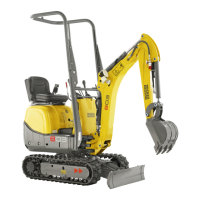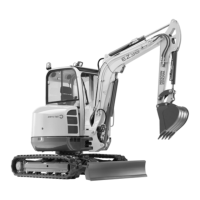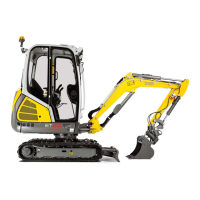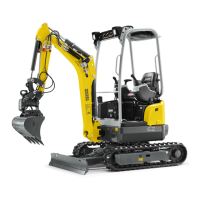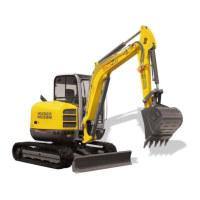1-4 OM 75Z3/8003 US – Edition 4.0 * * 7003b110.fm
Introduction
1.3 Brief description
The Wacker Neuson model 75Z3 / 8003 is a self-propelled hydraulic excavator. Before
operating the excavator, read the instruction manual, understand the instruction and prac-
tice operation until confident of operating familiarity and competence. Know and comply
with regulations for operation and use of the excavator on the worksite or traveling on pub-
lic roads. This excavator is intended for use as an earth-moving machine. Attachments
described in Chapter 1.4 “Fields Of Application of Attachments” are approved to expand
the utility of the 75Z3/8003 as an earth-moving machine. Do not use any other attach-
ments with the excavator. Contact the Wacker Neuson dealer for attachment advice for
equipment not described in 1.4.
Major excavator assemblies are:
• Rotating upper structure.
• Undercarriage supporting the upper structure.
• Propulsion system consisting of tracked travel gear and motor for machine mobility.
• Earthmoving structures (boom, stick and bucket).
The upper structure consists of the following major components or systems:
• Diesel engine/ pump drive.
• Pressure compensated hydraulic system.
• Operator compartment.
• Control systems for work and machine propulsion.
• Swing bearing and hydraulic coupling for upper and lower structure connection.
• Swing gear box and motor.
• Boom mounting points.
• Fuel and hydraulic oil reservoir.
• Counterweight.
• Engine and component enclosure.
The lower structure supports the upper structure through a large bearing permitting 360
degree continuous rotation:
• Welded structure.
• Large support bearing.
• Stabilizer blade.
• Track drive.
• Drive motor.
Hydraulic systems are supplied power from pumps mounted to a drive box bolted to the
diesel engine. The system is pressure compensated automatically adjusting speed and
force to the working conditions and engine power. The following functions are hydraulically
actuated:
• Upper structure rotation.
• Excavator mobility.
• Steering during excavator movement on the worksite or public roads.
• Stabilizer extension and retraction.
• Boom vertical movement.
• Stick movement in and out.
• Auxiliary hydraulics for attachments.
• Excavator propulsion brakes/park brake.
• Optional horizontal boom slewing motion.

